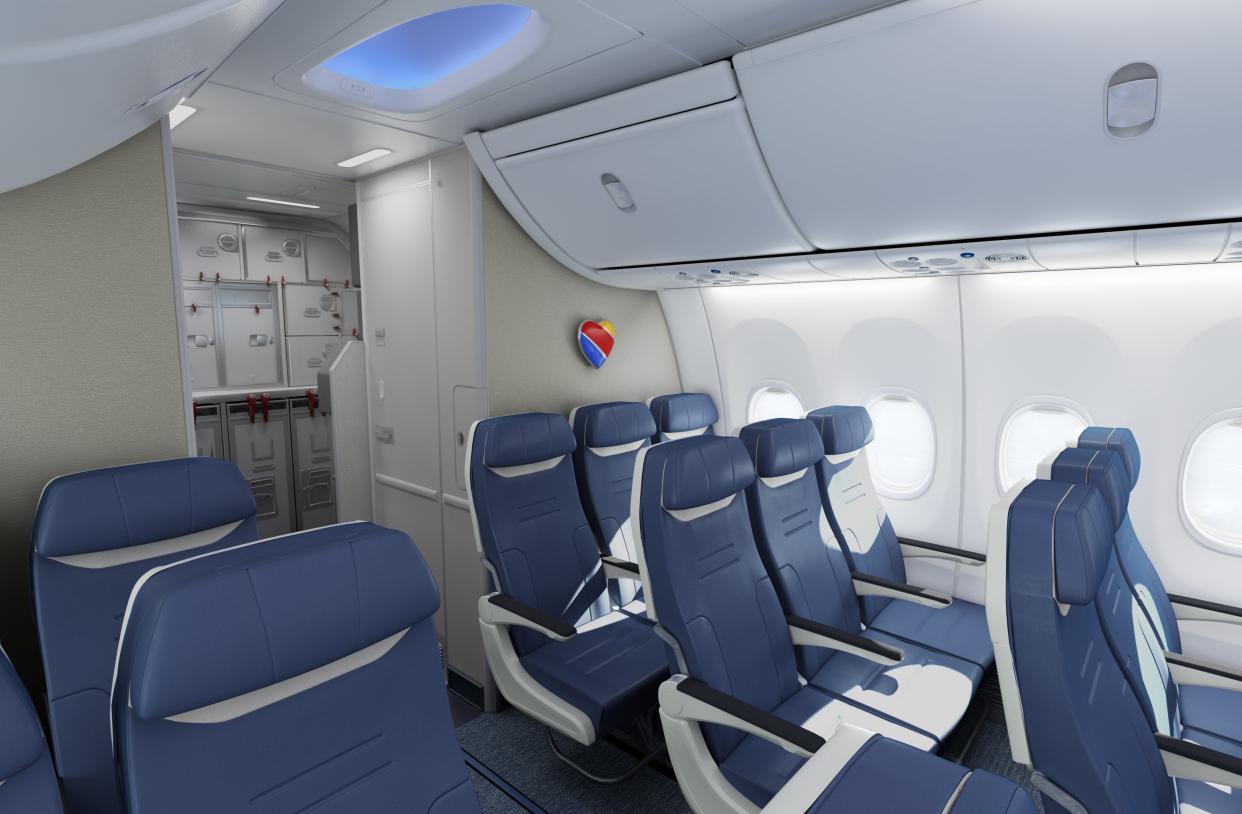Are airplane seats too small? FAA soliciting public comments on minimum dimensions
Congress ordered the Federal Aviation Administration to establish minimum dimensions for airplane seats within a year when the agency's funding was renewed in October 2018.
The FAA has yet to comply.
But this week the agency will take a step toward creating a new seat size regulation. The FAA is announcing an advanced notice of proposed rulemaking – a signal flare to interested members of the public that the agency is considering implementing that minimum size for airplane seats after all.
The notice will open a 90-day comment period during which the FAA will solicit feedback on possible airplane seat size standards.
"Congress directed the FAA to, after notice and comment, issue such rules for minimum dimensions for passenger seats that are necessary for passenger safety," the agency said in a copy of the notice that was provided to USA TODAY in advance. "The FAA seeks public comment on the minimum seat dimensions that are necessary for passenger safety."
JetBlue agrees to buy Spirit for $3.8 billion, 'but for now nothing is changing'
Your Southwest flight credits won't expire: Airline's new policy applies to all tickets
The notice, which will "likely publish next week in the federal register," comes amid a yearslong push by advocates to get the FAA to act on this issue.
The agency has already conducted updatedairplane evacuation tests using a mockup facility in Oklahoma City and studied hundreds of real-world evacuations to try to gather more information about how seat dimensions affect onboard safety.
Many advocates, however, say the FAA's efforts do not go far enough. They're urging Congress to do more to push the agency to establish seat standards quickly, and insist it's not just evacuation safety that's compromised by tighter cabin configurations, but passenger health and comfort as well.
Why the FAA is required to establish minimum airplane seat dimensions
FlyersRights.org, an airline passenger advocacy group, has been urging the creation of minimum seat dimensions since 2015. That effort got a boost during the 2018 FAA reauthorization when Congress agreed that the agency was not acting urgently enough to address densifying airplane cabins.
"Seats have continued to shrink by some airlines, and people are continuing to get larger," said Paul Hudson, president of FlyersRights.org. "Our estimate is that only 20% of the population can reasonably fit in these seats now. It’s beyond a matter of comfort, or even emergency evacuation, there are serious health and safety issues when you’re put in cramped conditions for hours on end."
Hudson said that tighter seats can increase the risk for serious health issues like deep vein thrombosis, especially on longer flights.
As part of the 2018 legislation, which funded the FAA for five years, Congress set requirements for the agency to study how seat size affects aircraft safety, including evaluating how evacuation testing on airplanes is conducted.
Current standards require evacuations to take 90 seconds or less for all passengers using half of the available emergency exists.
Congressman Steve Cohen, D-Tenn., who serves on the House Transportation and Infrastructure Committee said he strongly supported the language in the 2018 reauthorization bill and is frustrated that the FAA hasn't followed the timeline it set out.
"The seats have gotten smaller and smaller and smaller and it’s been pretty apparent to the naked eye and the traveling public that airplanes aren’t safe if there’s an emergency," he said in an interview with USA TODAY.
Professional travelers agree that tighter airplane cabins are a hazard.
"These smaller seats are a safety concern for people period," said Jeff Jenkins, an award-winning content creator and founder of Chubby Diaries. "If somebody was caught up in the window seat and it takes them a while to get out, it can be bad very quickly."

For plus-size travelers especially, densifying airplane cabins can be both a comfort and safety issue. Annette Richmond, founder of the Fat Girls Traveling Facebook group, said shrinking airplane seats are a health concern too.
As airplane seats get narrower, she said, "for someone who’s a little more hippy, it’s not uncomfortable, it’s painful. (The armrest is) pressing directly on the bone."
Richmond added that there's no standard length for airplane seat belts, which can further complicate things for plus-size travelers because it makes the necessity of a seat belt extender unpredictable.
"It does cause a big safety concern for plus-size people if they don't have two seats," Jenkins added.

What the FAA has done so far
The FAA conducted a new round of live evacuation testing at a facility in Oklahoma and studied real-world airplane evacuations for more data.
The tests, however, did not use an actual aircraft, and the test subjects were limited to able-bodied people between the ages of 18 and 60.
The agency acknowledged that that is not a representative cross-section of the American traveling public but insists that research ethics standards prohibit older, younger, or disabled people from participating in a simulation during which they could be injured.
Erica Oldham, a retired physician who has muscular dystrophy, is a frequent traveler and said airlines have shown a lot of improvement in how they treat disabled passengers over her lifetime, but she acknowledged it could potentially be difficult in emergencies for those with limited mobility.
"I’m traveling with my husband who obviously would just pick me up and get me off the plane," she said. "I feel most comfortable sitting in an aisle seat. That would be the easiest way to get off the plane."
Oldham added that she feels more secure when flight attendants take the time to ask her in advance about the best way to assist her evacuation in an emergency.
In a letter to the chair of the House Transportation Committee dated March 31, FAA Administrator Steve Dickson said the analysis of around 300 real-world evacuations bolstered the data from the agency's recent tests and helped show that the level of safety for airplane evacuations remains acceptable.
The changes passenger advocates want to see
Critics say that the FAA is not doing enough to analyze real-world scenarios and that more live evacuation testing is needed.
"The CDC says Americans have gotten bigger. The airlines have made the pitch tighter, and the width. We’ve seen checked baggage fees since the 2000s, so we’ve seen more carry-on baggage than we ever have," said William J. McGee, senior fellow for aviation at the American Economic Liberties Project. He added that more passengers are distracted by electronic devices, and more are bringing carry-on bags and pets or service animals than ever before.
"The FAA has not responded to the fact that the interior of a cabin on a U.S. airline is different than it was 20 years ago in multiple ways," McGee said. "You have a really, really bad combination of factors here, people who don’t fly a lot, airlines that are cramming them in, and an FAA that has been too laissez-faire on this whole thing."
Hudson, from FlyersRights.org, said that the FAA's approach to this issue has been too lenient so far.
"I got to witness part of the evacuation testing in Oklahoma City. The testing was completely unrealistic," he said. "Of the testing I witnessed, the ones that were in the narrower configurations, they were about 20% slower, but the conclusion of the reports was 'no, it made no difference' ... but they didn’t release their data, just their conclusions."
Congressman Cohen agreed that the FAA needs to find a way to make its tests more representative of the American population.
"They claim they couldn’t have people over a certain age or under a certain age because of liability factors," he said. "They're going to have a lot of liability if planes crash and people die.”
Until the FAA establishes an official seat policy, many advocates are calling for a moratorium on seat shrinkage, in other words: a rule that would bar airlines from further densifying their cabins until new standards are finalized.
A 2020 report from the Office of the Inspector General criticized the FAA for not updating its evacuation testing procedures to account for the changing realities of air travel.
The Inspector General's investigation also turned up just one example of airplane evacuation testing for a cabin configured with a 28-inch seat pitch. (Seat pitch is the distance from one point on the seat to the same point on the seat in front of it. Greater pitch generally means more legroom.) Spirit Airlines configures most of its jets, which are all variations of the Airbus A320, with a 28-inch pitch. That is typically seen as the tightest configuration in the U.S. market currently.
For comparison, Southwest's Boeing 737s generally have 31-33 inch seat pitch, and American Airlines' 737s and A320s typically have 30-32 inches of pitch in economy, according to SeatGuru. Boeing 737s and Airbus A320s are the workhorses of most airlines for domestic flights in the U.S.

What happens next?
There's still no guarantee that the FAA will establish minimum seat dimension standards. The end result of the public comment period and the studies the agency has conducted so far may be that the regulator decides no new rule is needed. But, opening the question for public comment suggests that this remains a live issue and that minimum airplane seat dimensions are a real possibility in the U.S.
Anyone can comment during this stage. Once the comment period concludes, the FAA will review the responses and continue its analysis. There's no definite timeline from the agency's perspective on when this rule will be established, but its funding is up for reauthorization again in 2023, and Cohen said that legislation will likely include a renewed requirement for the agency to address this topic.
He acknowledged, however, that such a requirement is essentially unenforceable because appropriations bills cannot be used to formally legislate. But, as the FAA continues to consider seat regulations, the 2023 reauthorization bill may be the next milestone to watch.
This article originally appeared on USA TODAY: FAA taking public comments for minimum plane seat sizes